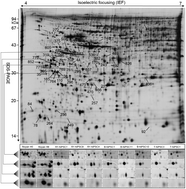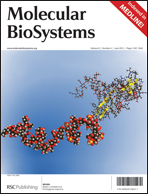An orthogonal comparison of the proteome of human embryonic stem cells with that of human induced pluripotent stem cells of different genetic background†
Abstract
Induced pluripotent stem cells (iPSCs) provide an invaluable resource for drug or toxicology screening, medical research and patient-specific cell therapy. However, the potential applications of iPSCs are largely dependent on the degree of similarity between iPSCs and embryonic stem cells (ESCs). In the present study, we analyzed the proteome of human ESCs and hiPSCs with different genetic background. We carried out an orthogonal contrast analysis of the proteome pattern of two human ESC lines (Royan H5 and Royan H6) and two hiPSC lines from a normal individual, three hiPSC lines from a normal individual with Bombay blood group phenotype, and two hiPSC lines from a patient with tyrosinemia. Forty-nine protein spots showed statistically significant differences between two human ESC lines and seven human iPSCs. Mass spectrometry analysis resulted in the identification of 48 proteins belonging to different biological processes, including cytoskeleton organization, energy and metabolic processes, protein synthesis and processing, signal transduction, cell growth and proliferation, cellular trafficking, transcription, calcium binding and immune response. Our results showed that hESCs and hiPSCs had subtle differences at the proteome level thus warranting more detailed and systematic examinations of these cells.


 Please wait while we load your content...
Please wait while we load your content...